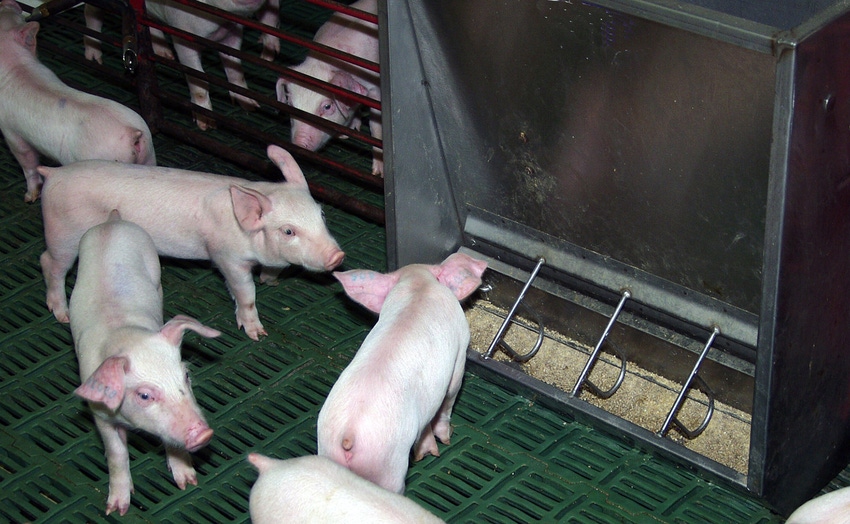Effects of excess dietary leucine in corn protein diets
HPCP may be included in diets for weanling pigs without affecting growth performance or blood characteristics, if extra Val, Ile and Trp is provided in the diets.
November 14, 2023

By Andrea Mallea and Hans Stein, University of Illinois
High protein corn protein is a co-product from the dry grind ethanol industry that contains approximately 50% crude protein, and can be included in diets for weanling pigs. However, like other corn proteins, HPCP has a high concentration of leucine, resulting in an excess dietary Leu in the diets if corn protein is used. As a consequence, pigs often have reduced growth performance if fed diets containing HPCP.
However, it may be possible to counteract the negative effects of the high Leu concentrations in corn co-products by adding crystalline sources of tryptophan, isoleucine and valine to the diets, but this hypothesis has not been experimentally verified in diets for weanling pigs. Therefore, an experiment was conducted to test the hypothesis that HPCP may be used as a source of amino acids in diets for weanling pigs if diets are fortified with crystalline Trp, Val, and Ile.
A total of 320 weanling pigs [body weight: 6.11 ± 0.66 kg] were randomly allotted to one of 10 dietary treatments. A two-phase feeding program was used with day 1 to 14 as phase 1 and day 15 to 28 as phase 2. A control diet based on corn and soybean meal was formulated and two diets were formulated based on corn and 10% HPCP or corn and 20% HPCP.
Seven additional diets were formulated by supplementing the diet with 20% HPCP with crystalline Ile, Trp and Val as follows:
HPCP + 0.10% Ile
HPCP + 0.05% Trp
HPCP + 0.10% Val
HPCP + 0.10% Ile + 0.10% Val
HPCP + 0.10% Ile + 0.05% Trp
HPCP + 0.10% Val + 0.05% Trp
HPCP + 0.10% Ile + 0.10% Val + 0.05% Trp
Individual pig weights were recorded at the beginning of the experiment and at the end of each phase. Daily feed allotments were recorded to calculate feed consumption. Fecal scores were assessed visually per pen every other day using a score from 1 to 5 (1 = normal feces; 2 = moist feces; 3 = mild diarrhea; 4 = severe diarrhea; and 5 = watery diarrhea).
Results indicated that inclusion of 10 or 20% HPCP in diets reduced (P < 0.05) final body weight on d 28, and average daily gain and average daily feed intake in phase 2 and for the entire experimental period were also reduced (P < 0.05) by adding HPCP to the diets (Table 1).
Pigs fed the control diet or the HPCP diet supplemented with all three crystalline amino acids had a greater (P < 0.05) final body weight and average daily gain in phase 2 and for the overall experiment than pigs fed diets supplemented with only one or two crystalline amino acids. However, pigs fed diets supplemented with Val, Val and Ile, or Val and Trp had greater (P < 0.05) final body weight and greater average daily gain in phase 2 and for the overall experiment than pigs fed diets containing only Ile, only Trp, or Ile and Trp.
Pigs fed the control diet or the diet with 20% HPCP and Val, Val and Ile, Val and Trp, or Val, Ile, and Trp had greater (P < 0.05) average daily feed intake in phase 2 and for the overall experiment than pigs fed diets with 10 or 20% HPCP and no crystalline amino acids or the diet with 20% HPCP and Ile and Trp.
From d 15 to d 28 and for the overall experiment, fecal scores were reduced (P < 0.05) if HPCP was included in the diet.
High protein corn protein contains approximately twice as much Leu compared with SBM, which results in diets containing HPCP having an excess of dietary Leu. Excess Leu in diets for pigs increases Val catabolism, which may result in a deficiency of Val for protein synthesis. High levels of Leu in diets also is detrimental to Trp metabolism because excess dietary Leu may prevent Trp from being transported to the brain where it is needed as a precursor for serotonin, which regulates feed intake. As a consequence, reduced Trp in the brain can result in reduced serotonin synthesis, which may result in reduced feed intake.
Indeed, in the present experiment, pigs fed diets containing HPCP without synthetic amino acids had reduced feed intake. However, the observation that pigs fed the diet containing HPCP and Val, Ile and Trp had growth performance that was not different from the control diet indicates that the negative effects of Leu in corn protein can be overcome if HPCP-diets are fortified with crystalline Val, Ile and Trp.
In conclusion, the negative effect of including HPCP in diets for weanling pigs may be overcome with supplementation of crystalline Val, Trp and Ile. Therefore, HPCP may be included in diets for weanling pigs without affecting growth performance or blood characteristics, if extra Val, Ile and Trp is provided in the diets. In the present work diets contained 0.10% extra Val and Ile and 0.05% extra Trp. Future research should focus on determining if lower levels of these amino acids can be used without reducing growth performance of pigs.
You May Also Like



